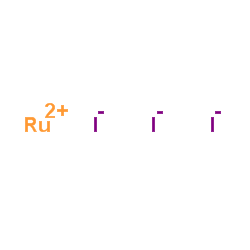20427-56-9
| 中文名 | 四氧化钌 |
|---|---|
| 英文名 | tetraoxoruthenium |
| 中文别名 | 氧化钌 |
| 英文别名 |
EINECS 243-813-8
Ruthenium(VIII) oxide ruthenium oxide ruthenium tetraoxide Ruthenium tetroxide |
| 密度 | 3.290 |
|---|---|
| 沸点 | 40ºC (other sources give 108ºC; presumably40ºC is at reduced pressure) |
| 熔点 | 25.4ºC |
| 分子式 | O4Ru |
| 分子量 | 165.06800 |
| 精确质量 | 165.88400 |
| PSA | 68.28000 |
| 外观性状 | Crystalline Powder | White |
| 储存条件 | Refrigerator (+4°C) |
| 稳定性 | 四氧化钌是一个非常危险的试剂,能够与滤纸和醇发生爆炸性反应,与醚、苯和吡啶的反应也非常剧烈。它能够很容易地氧化人体内组织,留下二氧化钌沉积,它的蒸气能强烈刺激眼睛和呼吸道,因此使用时一定要避免吸入。但是,当反应中只存在催化剂量的四氧化钌时,上述危险性能大大降低。 |
| 水溶解性 | 2.03g/100mL H2O (20°C); very soluble CCl4, other chlorinated hydrocarbons [MER06] [KIR82] |
| 计算化学 | 1.疏水参数计算参考值(XlogP):无 2.氢键供体数量:0 3.氢键受体数量:4 4.可旋转化学键数量:0 5.互变异构体数量:无 6.拓扑分子极性表面积68.3 7.重原子数量:5 8.表面电荷:0 9.复杂度:138 10.同位素原子数量:0 11.确定原子立构中心数量:0 12.不确定原子立构中心数量:0 13.确定化学键立构中心数量:0 14.不确定化学键立构中心数量:0 15.共价键单元数量:1 |
| 更多 | 1.溶解性:极易溶于氯仿和四氯化碳,微溶于水。它具有两种形态,其中黄色四氧化钌mp 25.5 oC,bp 40 oC;橙色四氧化钌mp 27 oC,bp 108 oC。 |
|
Section 1: Product Identification Chemical Name:Ruthenium(VIII) oxide (0.5% stabilized aqueous solution) CAS Registry Number:20427-56-9 Formula:RuO4 EINECS Number:none Chemical Family:metal oxide Synonym:ruthenium tetroxide
Section 2: Composition and Information on Ingredients IngredientCAS NumberPercentACGIH (TWA)OSHA (PEL) Title Compound20427-56-90.5%no datano data Section 3: Hazards Identification Emergency Overview:Irritating to skin, eyes and mucous membranes. May be harmful if swallowed. Primary Routes of Exposure:Ingestion, eyes Eye Contact:Causes slight to mild irritation of the eyes. Skin Contact:Causes slight to mild irritation of the skin. Inhalation:Irritating to the nose, mucous membranes and respiratory tract. Ingestion:No specific information is available on the physiological effects of ingestion. Acute Health Affects:Irritating to skin, eyes and respiratory tract. Chronic Health Affects:Exposure to ruthenium tetroxide dust and vapors may cause severe permanent damage to eyes and lungs. NTP:No IARC:No OSHA:No SECTION 4: First Aid Measures Immediately flush the eyes with copious amounts of water for at least 10-15 minutes. A victim may need Eye Exposure: assistance in keeping their eye lids open. Get immediate medical attention. Wash the affected area with water. Remove contaminated clothes if necessary. Seek medical assistance if Skin Exposure: irritation persists. Remove the victim to fresh air. Closely monitor the victim for signs of respiratory problems, such as difficulty Inhalation: in breathing, coughing, wheezing, or pain. In such cases seek immediate medical assistance. Seek medical attention immediately. Keep the victim calm. Give the victim water (only if conscious). Induce Ingestion: vomiting only if directed by medical personnel. SECTION 5: Fire Fighting Measures Flash Point:not applicable Autoignition Temperature:not applicable Explosion Limits:not applicable Extinguishing Medium:Aqueous solution - non-flammable When dry acts as an oxidizer towards organics. Smothering the fire may not be effective. A NIOSH approved Special Fire Fighting Procedures: self contained breathing apparatus should be worn. Hazardous Combustion andToxic ruthenium tetroxide could be present in gasses. Decomposion Products: Wetting the dried solid with small amounts of alcohols, solvents or combustible powders may lead to ignition Unusual Fire or Explosion Hazards: and fire. SECTION 6: Accidental Release Measures Small spills should be flushed with sodium bisulfite solution to detoxify ruthenium tetroxide, and then be mixed Spill and Leak Procedures: with vermiculite or sodium carbonate and swept up. Do not mix with combustible materials. SECTION 7: Handling and Storage Handling and Storage:Store in a cool dark place in tightly closed containers. SECTION 8: Exposure Controls and Personal Protection Eye Protection:Always wear approved safety glasses when handling a chemical substance in the laboratory. Skin Protection:Wear appropriate chemical resistant gloves and protective clothing. Ventilation:Material may form a fine dust or vapor. If possible, handle the material in an efficient fume hood. If ventilation is not available a respirator should be worn. The use of respirators requires a Respirator Respirator: Protection Program to be in compliance with 29 CFR 1910.134. Ventilation:Material may form a fine dust or vapor. If possible, handle the material in an efficient fume hood. Additional Protection:No additional protection required. SECTION 9: Physical and Chemical Properties Color and Form:yellow liq. Molecular Weight:165.7 Melting Point:no data Boiling Point:(water) Vapor Pressure:no data Specific Gravity:no data Odor:acrid odor Solubility in Water:material is a water solution SECTION 10: Stability and Reactivity Stability:heat sensitive, (store cold, in the dark) Hazardous Polymerization:no hazardous polymerization Conditions to Avoid:The dry powder reacts violently with paper, alcohol, and other combustibles. Incompatibility:Reducing agents, organic materials, active metals and halogens Decomposition Products:ruthenium and oxygen SECTION 11: Toxicological Information RTECS Data:No information available in the RTECS files. Carcinogenic Effects:No data available Mutagenic Effects:No data available Tetratogenic Effects:No data available SECTION 12: Ecological Information Ecological Information:No information available SECTION 13: Disposal Considerations Disposal:Dispose of according to local, state and federal regulations. SECTION 14: Transportation Shipping Name (CFR):Oxidizing liquid, N.O.S. Hazard Class (CFR):5.1 Additional Hazard Class (CFR):NA Packaging Group (CFR):II UN ID Number (CFR):UN# 3139 Shipping Name (IATA):Oxidizing liquid, N.O.S. Hazard Class (IATA):5.1 Additional Hazard Class (IATA):NA Packaging Group (IATA):II UN ID Number (IATA):UN# 3139 SECTION 15: Regulatory Information TSCA:Not listed in the TSCA inventory. SARA (Title 313):Title compound not listed. Second Ingredient:none SECTION 16 - ADDITIONAL INFORMATION N/A |
| 安全声明 (欧洲) | S16-S17-S36-S37-S39 |
|---|---|
| 危险品运输编码 | UN 3139 |
| 包装等级 | I |
| 危险类别 | 5.1 |
| 海关编码 | 28439000 |
| 上游产品 7 | |
|---|---|
| 下游产品 4 | |





















